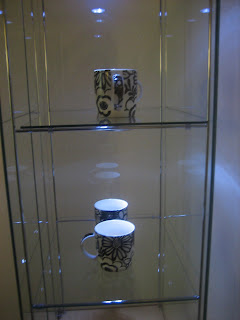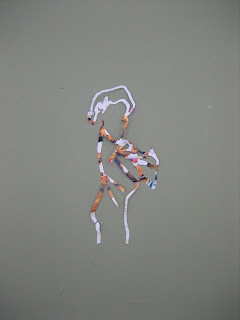Working primarily on self portraiture, I am interested in the idea of a self portrait not being a photorealistic depiction of the face, but am concerned with a self portrait being a trace or mark of identity or revelation about the artist and how they represent the idea of the ‘self’.
Andy Warhol’s ideas and representation of himself has been highly influential to my practice. I’m very interested in his idea of a self portrait not being an honest depiction of the artist but a means for critical self analysis and reflection through a constructed and idealised representation of perfection. Warhol shows himself as he wishes to be seen, not as he sees himself, obliterating all blemishes and signs of ageing or imperfections. In creating a completely false construction of his image, Warhol admits his imperfections and in that reveals his true identity.
My studio work focuses largely on the use of a blind contour drawing method in which I concentrate solely on the subject or image to be drawn, and not on the drawing being produced. The effect is that the drawing becomes uncontrolled and dislocated, and remains unedited to gain a sense of the ‘real’ image. I use this method as I’m interested in the theory that self analysis is almost unreal because a person becomes disillusioned, and perhaps don’t see what really is there. This way, in focussing entirely on the aesthetic outlines of the person as the subject, you get a more appropriate outcome of drawing than if it was produced with the intention of realism.
I have experimented with different materials, such as lace, paper cuttings and leather- looking vinyl and I like the idea of how different materials can connote different thoughts or feelings for the audience, i.e., lace produces a delicate and feminine idea, whilst leather has certain masculine or sexual associations. So in producing portraiture from these materials, the persona of the figure in the work automatically changes to fit the ideology of the material in use.
More recently I have become interested in the ‘Body tracks’ paintings of Ana Mendieta. These appeal to me as they are not primarily focussed on creating a self portrait or an image of identity, but work on literally leaving a trace of the body and its movements. The unpredictability of the outcome reflects elements of control vs. chaos within my own work, which I would like to develop further, possibly through a wider or more extensive range of materials.
Influenced by Mendieta I have created some of my own body tracks where I dragged my body through paint to leave different traces of myself, and also made prints from my own body. In selecting the more interesting pieces I made line drawings from them and cut them from different materials. The nature of how the original paintings were made from my body means they are quite abstract, and once turned into a line drawing cut from vinyl the pieces look oddly like a map or atlas. This interests me in terms of showing traces of my body and movements, and the whole idea of exploring how people construct their image.




































